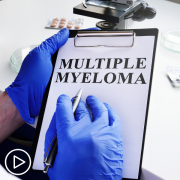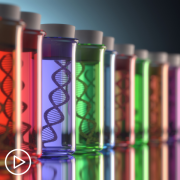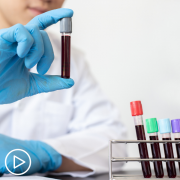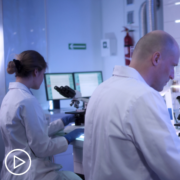Which Tests Are Essential to Diagnose and Treat Myeloma?
Which Tests Are Essential to Diagnose and Treat Myeloma? from Patient Empowerment Network on Vimeo.
Several tests follow a myeloma diagnosis and continue throughout one’s care. Myeloma expert Dr. Saad Usmani provides an overview of these essential tests, including blood tests and cytogenetics, and how the results impact overall treatment options.
Dr. Saad Usmani is the Chief of Myeloma Service at Memorial Sloan Kettering Cancer Center in New York City. Learn more about Dr. Usmani, here.
Related Programs:

How Is Minimal Residual Disease (MRD) Testing Used in Myeloma Care? |

|

|
Transcript:
Katherine Banwell:
What tests are necessary to help understand a patient’s specific disease both at diagnosis and prior to treatment?
Dr. Usmani:
So, the testing includes – what’s the objective of testing – we do tests to help diagnosis to assess how much of cancer we’re dealing with and then what kind of cancer we’re dealing with. Even within a given cancer, how much cancer you have and what kind you have is important. Folks can have a little bit of cancer in terms of burden. But it can be aggressive in its nature. So, you can have King Kong at your door, or it could be the green giant just trying to serve up veggies. Whereas King Kong will bite your head off.
So, with that in mind, there are things that we do such as blood tests to see effects on blood counts, kidneys, liver. We also do certain blood tests to identify what kind of multiple myeloma a patient may have as an example. So, the kind of myeloma protein they’re secreting. The kind of light chain they’re secreting. Then urine tests are done to see if there are any proteins that are leaking through the kidneys if there is kidney damage. Then bone marrow biopsy to a) look at how much myeloma and b) what kind by specific testing that we do on the bone marrow biopsy. And then imaging to see what parts of the bone’s affected.
Katherine Banwell:
Great. I’m assuming that these tests will help with the opening of the stages of myeloma.
So, how is myeloma staged?
Dr. Usmani:
So, the staging of myeloma is still a work in progress. The reason why I say that is we have a good way of accessing how much myeloma a patient may have. But if we don’t combine it well with what kind or how aggressive it may be. So, staging in myeloma relies on two blood tests that are serum albumin and serum beta-2 macroglobulin.
And they help us give a good assessment of how much myeloma patients have. And maybe a little bit of information about whether patients may have a bit more aggressive kind. But then you overlay that with cytogenetic information from the myeloma cells that are from the biopsy as well as another blood test called LDH.
If patients have any of the quote unquote high-risk features, they are – along with a high level of beta-2 microglobulin, you stage them as stage 3. If they don’t have them, they’re stage 1. If they have some of the features, they’re kind of in between in stage 2. And that’s how we stage multiple myeloma.
Katherine Banwell:
You mentioned cytogenetics. What testing is involved in that?
Dr. Usmani:
So, bone marrow biopsy – it’s very broad. But there are two parts to it.
One part is getting the bone marrow aspirated where we insert a needle into the pelvic bone and get parts of the bone marrow – the blood inside the bones out. And look at how much percentage of plasma cells are there. What kind of surface markers or features they have.
And then we look at if those cancer cells have any chromosome abnormalities that are unique to myeloma. And some chromosome abnormalities can be high-risk.
What does high-risk mean? High-risk means if you treat patients in a certain fashion, they have a higher chance of relapsing or a higher chance of the myeloma coming back out of remission. So, we identify those features by way of looking at cytogenetics. And there are different techniques in which we can take a look at that.
Katherine Banwell:
And what are those techniques? There’s something called FISH, right?
Dr. Usmani:
Yes.
Katherine Banwell:
And flow cytometry and also next generation sequencing?
Dr. Usmani:
Yes. So, and there is also conventional cytogenetics. So, flow cytometry looks at the different proteins that are part of the surface of any cell – any blood cell for that matter. It could also be any other cell as well, not just blood cells.
But in this particular case when we do flow on the blood marrow aspirate, we’re looking for unique features of those myeloma cells. But that does not tell us anything about the chromosomes. Conventional cytogenetics is the old fashion way. It’s a 40 – 50-year-old technique in which you make the cells in a test tube. You make those cells go through cell division. Each human cell has 46 chromosomes or 23 pairs. And when the cells are dividing, those chromosomes kind of line up in the center.
And the old fashion technique of conventional cytogenetics was take a look at the cells when those cells – when the chromosomes are aligned, and see if some parts of the chromosomes are missing or one chunk of one chromosome has attached to the other. That’s the old fashion way. The FISH technique, what it does is it’s geared toward identifying specific abnormalities.
And one part of that particular protein or molecule that goes and attaches to that chromosome has a color-coded probe. So, you can see within a cell different colors light up. And based on those unique features, you can identify “Okay. This cell over here is missing a part of chromosome 17. Or this part of chromosome 14 is attached to chromosome 4.” That’s FISH. So, FISH is very specific. Conventional cytogenetics is not. Next-generation sequencing, there are – that’s a broad term.
You can measure different types of nucleic acids: RNA versus DNA. And those different techniques identify specific – they can identify specific mutations in a cancer cell.
So, each of these techniques provide different layers of information for our myeloma patients.










